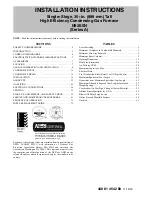
The size of the openings depends upon whether the air comes from
outside of the structure or an unconfined space inside the structure.
A.
All Air from Inside the Structure
For a confined space, where air is taken from an interior space, 2
permanent openings of equal area are required. One opening must
be within 12 in. of ceiling and the other within 12 in. of floor. Each
opening must have a free area of at least 1 sq in. per 1000 Btuh of
total input rating but not less than 100 sq in. (Refer to Table 4.)
B.
All Air from Outside of Structure
If outside air is supplied to a confined space, then the 2 openings
must be equal and located as above.
1. If combustion air is taken through a permanent opening
directly communicating with the outdoors, the opening shall
have a minimum free area of 1 sq in. per 4000 Btuh of total
input rating for all equipment in the enclosure.
2. If combustion air is taken from outdoors through vertical
ducts, the openings and ducts MUST have at least 1 sq in.
of free area per 4000 Btuh of the total input for all
equipment within the confined space. (Refer to Table 5.)
3. If combustion air is taken from outdoors through horizontal
ducts, the openings and ducts MUST have at least 1 sq in.
of free area per 2000 Btuh of the total input for all
equipment within the confined space. (Refer to Table 6.)
When ducts are used to supply air, they must be of the same cross
sectional area as free area of openings to which they connect.
The minimum dimension of rectangular air ducts must not be less
than 3 in.
C.
Duct Work Recommendations
WARNING:
CARBON MONOXIDE POISONING
HAZARD
Failure to follow this warning could result in personal
injury or death.
When supply ducts carry air circulated by furnace to areas
outside spaces containing furnace, return air MUST also
be handled by a duct sealed to furnace casing and
terminating outside space containing furnace.
CAUTION:
FIRE HAZARD or UNIT MAY
NOT OPERATE
Failure to follow this caution may result in property
damage or intermittent unit operation.
Return-air grilles and warm air registers MUST NOT be
obstructed.
The proper sizing of warm air ducts is necessary to ensure
satisfactory furnace operation. Duct work should be in accordance
with the latest editions of NFPA-90A (Installation of Air Condi-
tioning and Ventilating Systems) and NFPA-90B (Warm Air
Heating and Air Conditioning Systems) or Canadian equivalent.
The supply duct work should be attached to flanged front opening
provided at discharge end of furnace. The return-air duct work
should be attached to flanged rear opening of furnace. See Fig. 2
for dimensions of these openings.
NOTE:
The back (blower access opening) should not be used for
return air.
The following recommendations should be followed when install-
ing duct work:
1. Install locking-type dampers in all branches of individual
ducts to balance out system. Dampers should be adjusted to
impose proper static at outlet of furnace
2. A flexible duct connector of noncombustible material
should be installed at unit on both supply- and return-air
systems. In applications where extremely quiet operation is
necessary, the first 10 ft (if possible) of supply and return
ducts should be internally lined with acoustical material.
3. In cases where return-air grille is located close to fan inlet,
there should be at least one 90° air turn between fan inlet
and grille. Further reduction in sound level can be accom-
plished by installing acoustical air turning vanes or lining
duct as described in item 2 above.
4. When a single air grille is used, duct between grille and
furnace must be the same size as return opening in furnace.
D.
Venting
Venting of furnace should be to the outside and in accordance with
local codes or requirements of local utility.
OIL-FIRED APPLIANCES SHALL BE CONNECTED TO
FLUES HAVING SUFFICIENT DRAFT AT ALL TIMES TO
ENSURE SAFE AND PROPER OPERATION OF APPLIANCE.
For additional venting information, refer to ANSI/NFPA 211
Chimney, Fireplaces, Vents, and Solid Fuel Burning Appliances
and/or CSA B139 Installation Code.
This furnace is certified for use with Type
″
L
″
vent (maximum flue
gas temperature 575°F).
VENT SYSTEM INSPECTION
Before furnace is installed, it is highly recommended that any
existing vent system be completely inspected.
TABLE 4—COMBUSTION AIR FROM
UNCONFINED SPACE
368RAN FURNACE
INPUT BTUH
FREE AREA PER
OPENING
(SQ IN.)
70,000
100
91,000
100
105,000
105
119,000
119
140,000
140
154,000
154
TABLE 5—COMBUSTION AIR FROM
OUTDOORS THROUGH VERTICAL DUCTS
368RAN FURNACE
INPUT BTUH
FREE AREA PER
OPENING
(SQ IN.)
ROUND PIPE
(IN. DIAM)
70,000
17.5
5
91,000
22.8
6
105,000
26.3
6
119,000
29.8
6
140,000
35.0
6
154,000
38.5
6
TABLE 6—COMBUSTION AIR FROM OUTDOORS
THROUGH HORIZONTAL DUCTS
368RAN FURNACE
INPUT BTUH
FREE AREA PER OPENING
(SQ IN.)
ROUND PIPE
(IN. DIAM)
70,000
35.0
7
91,000
45.5
8
105,000
52.5
9
119,000
59.5
9
140,000
70.0
10
154,000
77.0
10
—5—
Содержание 368RAN Series A
Страница 8: ...Fig 3 Wiring Diagram A04182 8...































